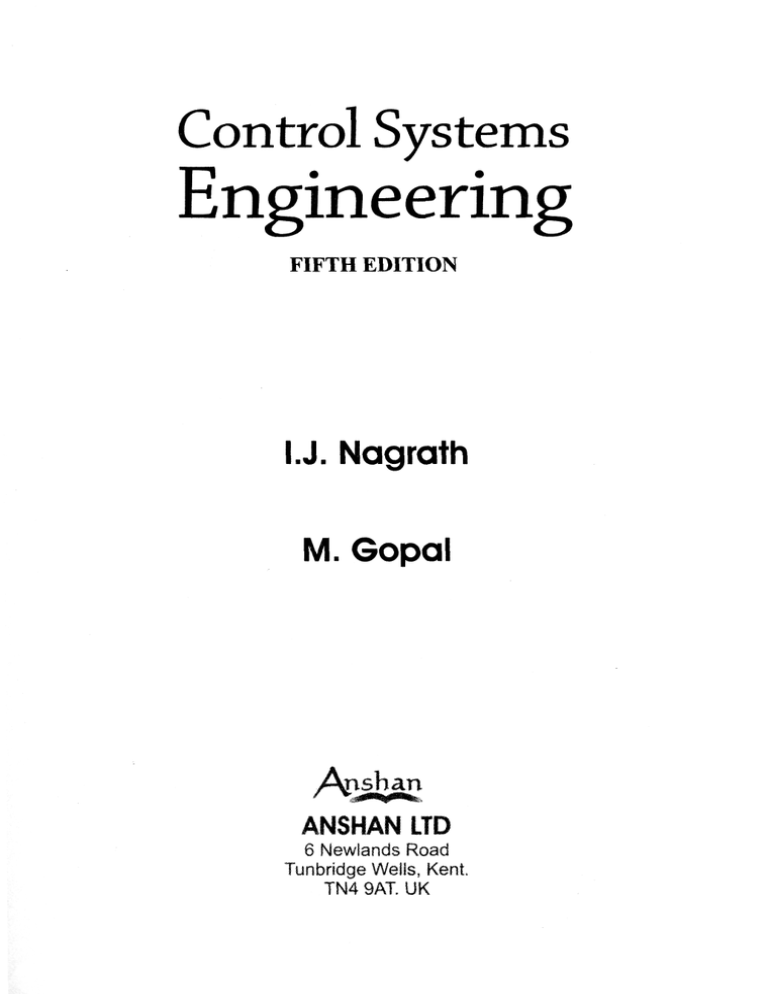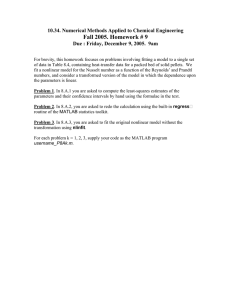Engineering
advertisement

Control Systems Engineering FIFTH EDITION I.J. Nagrath M. Gopal Ansh an ANSHAN LTD 6 Newlands Road Tunbridge Welis, Kent, TN4 9AT, UK CONTENTS Preface to the Fifth Edition Preface to the Third Edition 1. INTRODUCTION 1.1 1.2 1.3 1.4 1.5 1.6 2. 3. 4. 91-129 Feedback and Non-feedback Systems 92 Reduction of Parameter Variations by Use of Feedback 93 Control Over System Dynamics by Use of Feedback 97 Control of the Effects of Disturbance Signals by Use of Feedback 100 Linearizing Effect of Feedback 102 Regenerative Feedback 103 Illustrative Examples 104 Problems 119 CONTROL SYSTEMS AND COMPONENTS 4.1 4.2 21-90 Introduction 22 Differential Equations of Physical Systems 24 Dynamics of Robotic Mechanisms 42 Transfer Functions 46 Block Diagram Algebra 54 Signal Flow Graphs 62 Illustrative Examples 72 Problems 83 FEEDBACK CHARACTERISTICS OF CONTROL SYSTEMS 3.1 3.2 3.3 3.4 3.5 3.6 3.7 1-20 The Control System 2 Servomechanisms 6 History and Development of Automatic Control 10 Digital Computer Control 14 Application of Control Theory in Non-engineering Fields 18 The Control Problem 19 MATHEMATICAL MODELS OF PHYSICAL SYSTEMS 2.1 2.2 2.3 2.4 2.5 2.6 2.7 v vii Introduction 132 Linear Approximation of Nonlinear Systems 133 131-192 CONTENTS 4.3 4.4 4.5 4.6 5. Controller Components 134 Stepper Motors 154 Hydraulic Systems 163 Pneumatic Systems 177 Problems 185 TIME RESPONSE ANALYSIS, DESIGN SPECIFICATIONS 193-268 AND PERFORMANCE INDICES 5.1 5.2 5.3 5.4 5.5 5.6 5.7 5.8 5.9 5.10 5.11 5.12 5.13 6. CONCEPTS OF STABILITY AND ALGEBRAIC CRITERIA 6.1 6.2 6.3 6.4 6.5 6.6 6.7 7. Introduction 194 Standard Test Signals 195 Time Response of First-order Systems 197 Time Response of Second-order Systems 199 Steady-state Errors and Error Constants 210 Effect of Adding a Zero to a System 214 Design Specifications of Second-order Systems 215 Design Considerations for Higher-order Systems 221 Performance Indices 223 Illustrative Examples 227 Robotic Control Systems 237 State Variable Analysis—Laplace Transform Technique 245 The Approximation of Higher-order Systems by Lower-order 248 Problems 261 The Concept of Stability 270 Necessary Conditions for Stability 275 Hurwitz Stability Criterion 277 Routh Stability Criterion 278 Relative Stability Analysis 287 More on the Routh Stability Criterion 290 Stability of Systems Modelled in State Variable Form 291 Problems 293 T H E R O O T LOCUS TECHNIQUE 7.1 7.2 7.3 7.4 7.5 7.6 7.7 269-295 297-343 Introduction 298 The Root Locus Concepts 299 Construction Foot Loci 302 Root Contours 327 Systems with Transportation Lag 332 Sensitivity of the Roots of the Characteristic Equation 334 MATLAB: Tool for Design and Analysis of Control Systems—Appendix III 340 Problems 340 CONTENTS 8. FREQUENCY RESPONSE ANALYSIS 8.1 8.2 8.3 8.4 8.5 8.6 8.7 8.8 9. 11. 425-511 The Design Problem 426 Preliminary Considerations of Classical Design 428 Realization of Basic Compensators 435 Cascade Compensation in Time Domain 440 Cascade Compensation in Frequency Domain 459 Tuning of PID Controllers 477 Feedback Compensation 483 Robust Control System Design 490 Problems 506 DIGITAL CONTROL SYSTEMS 11.1 11.2 11.3 11.4 11.5 11.6 11.7 11.8 11.9 377-423 Introduction 378 Mathematical Preliminaries 378 Nyquist Stability Criterion 381 Assessment of Relative Stability Using Nyquist Criterion 394 Closed-loop Frequency Response 409 Sensitivity Analysis in Frequency Domain 417 Problems 420 INTRODUCTION TO DESIGN 10.1 10.2 10.3 10.4 10.5 10.6 10.7 10.8 345-376 Introduction 346 Correlation between Time and Frequency Response 347 Polar Plots 352 Bode Plots 355 All-pass and Minimum-phase Systems 366 Experimental Determination of Transfer Functions 367 Log-magnitude versus Phase Plots 370 MATLAB: Tool for Design and Analysis of Control Systems—Appendix III 371 Problems 374 STABILITY IN FREQUENCY DOMAIN 9.1 9.2 9.3 9.4 9.5 9.6 10. XI Introduction 514 Spectrum Analysis of Sampling Process 517 Signal Reconstruction 519 Difference Equations 519 The 2-transform 521 The 2-transfer Function (Pulse Transfer Function) 531 The Inverse 2-transform and Response of Linear Discrete Systems 535 The 2-transform Analysis of Sampled-data Control Systems 538 The 2-and s-domain Relationship 548 513-568 CONTENTS XII 11.10 Stability Analysis 549 11.11 Compensation Techniques 558 Problems 564 12. STATE VARIABLE ANALYSIS AND DESIGN 12.1 12.2 12.3 12.4 12.5 12.6 12.7 12.8 12.9 Introduction 570 Concepts of State, State Variables and State Model 571 State Models for Linear Continuous-Time Systems 578 State Variables and Linear Discrete-Time Systems 596 Diagonalization 599 Solution of State Equations 604 Concepts of Controllability and Observability 617 Pole Placement by State Feedback 625 Observer Systems 632 Problems 634 13. LIAPUNOV'S STABILITY ANALYSIS 13.1 13.2 13.3 13.4 663-712 Introduction 664 Parameter Optimization: Servomechanisms 665 Optimal Control Problems: Transfer Function Approach 673 Optimal Control Problems: State Variable Approach 684 The State Regulator Problem 688 The Infinite-time Regulator Problem 697 The Output Regulator and the Tracking Problems 702 Parameter Optimization: Regulators 704 Problems 707 15. NONLINEAR SYSTEMS 15.1 15.2 15.3 15.4 15.5 15.6 15.7 641-662 Introduction 642 Liapunov's Stability Criterion 646 The Direct Method of Liapunov and the Linear System 650 Methods of Constructing Liapunov Functions for Nonlinear Systems 652 Problems 660 14. OPTIMAL CONTROL SYSTEMS 14.1 14.2 14.3 14.4 14.5 14.6 14.7 14.8 569-640 Introduction 714 Common Physical Nonlinearities 719 The Phase-plane Method: Basic Concepts 723 Singular Points 725 Stability of Nonlinear System 731 Construction of Phase-trajectories 734 The Describing Function Method: Basic Concepts 742 713-764 CONTENTS XIII 15.8 Derivation of Describing Functions 743 15.9 Stability Analysis by Describing Function Method 749 15.10 Jump Resonance 757 Problems 759 16. ADVANCES IN CONTROL SYSTEMS 765-815 16.1 Introduction 766 16.2 Adaptive Control 767 16.3 Fuzzy Logic Control 783 16.4 Neural Networks 801 Problems 812 APPENDICES Appendix-I Fourier and Laplace Transforms and Partial Fractions 818 Appendix-II Elements of Matrix Analysis 827 Appendix-Ill MATLAB: Tool for Design and Analysis of Control Systems 836 Appendix-TV Final Value Theorem 848 Appendix-V Proof of a Transformation 849 Appendix-VI Answers to Problems 852 BIBLIOGRAPHY 869-886 INDEX 887-895



